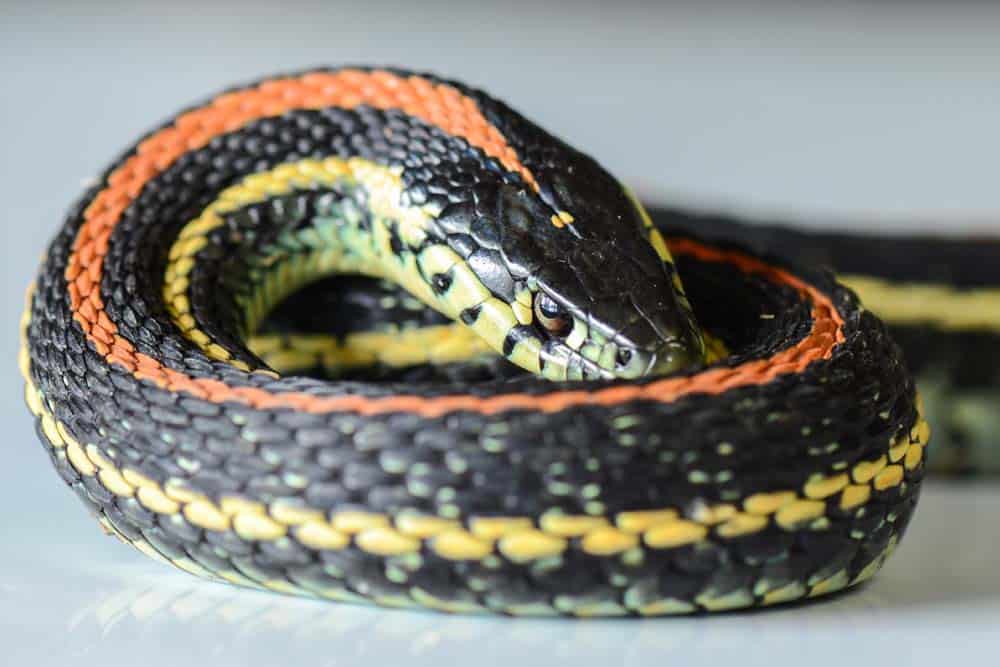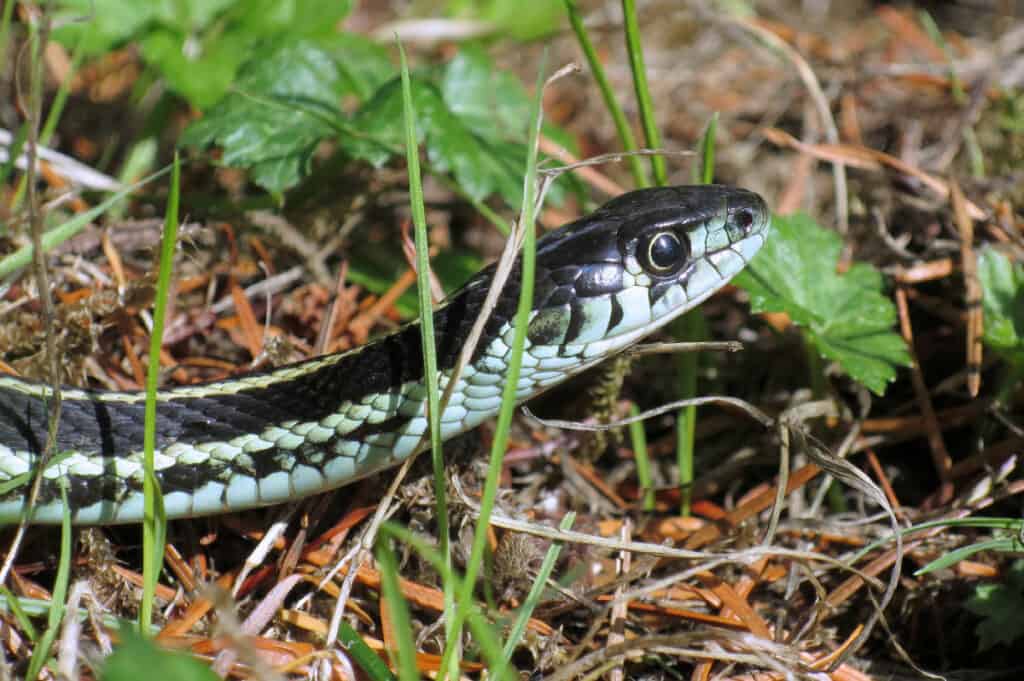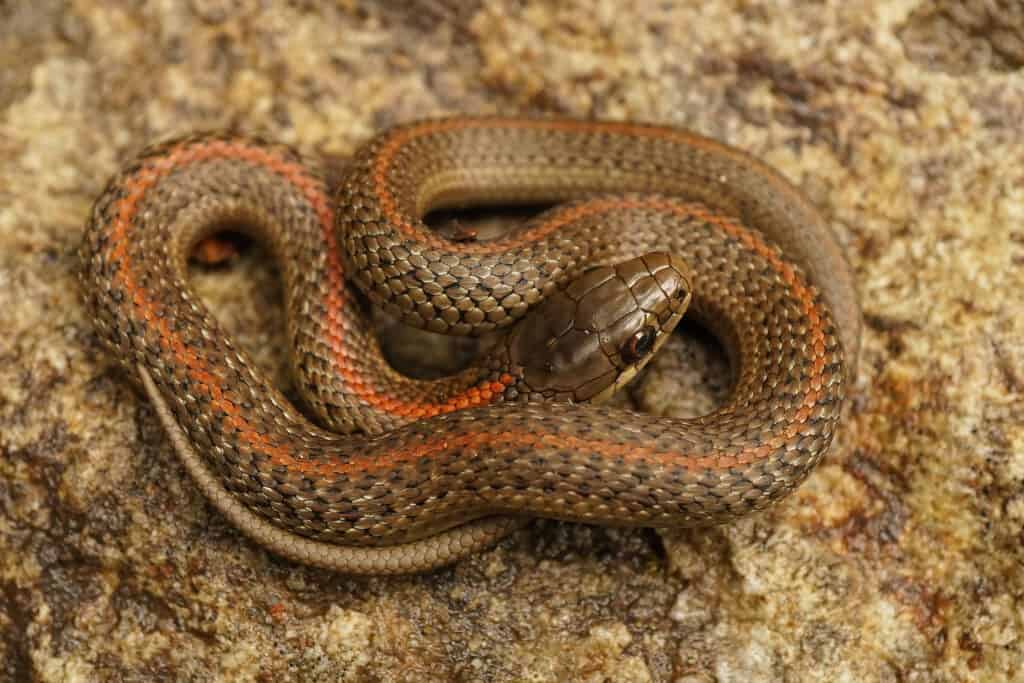Washington lies in the uppermost portion of the Pacific Northwest in the United States. The Cascade mountains run through the middle of the state, dividing it into east and west. Washington is well known for its wet winters and abundant rainfall. But compared to the west side of the state, the east is relatively dry. The west sides rainy season can be rough for many snakes, as cold-blooded reptiles. However, there are over 11 species of snakes that find a home in this state, including garters! Let’s have a look at garter snakes in Washington and find out which species live here, how to identify them and where in the state they reside.
Get Familiar with the Garter Snake

There are 3 species of garter snakes that live in Washington; the common, western terrestrial and northwestern garter snakes.
©Lost Mountain Studio/Shutterstock.com
The garter snake is part of the Natricinnae subfamily. Most in this group give birth to live young, including garters. There are about 35 garter snake species and many subspecies. Their common name comes from their resemblance to garters used to hold socks up. Their genus name Thamnophis comes from the word thamnos for ‘bush or shrub,’ and ophio, meaning ‘snake.’ As snakes, they are ectotherms whose temperature is fully dependent on environmental conditions. They regulate their bodies temperature by either absorbing or giving off heat. You might find garter snakes in shady areas during the heat of the day or sunning themselves on rocks when it’s time to warm up.
Garters are adaptable snakes that can thrive in a variety of habitats and eat an assortment of different prey. You can find them in woods, open fields, plains and brush-filled areas. They often prefer to live near water, at the edges of rivers, streams, ponds and lakes. It’s not uncommon to spot them basking in the sun on woodpiles, hedges and rocks. Garter snakes eat amphibians like frogs, toads and salamanders, as well as other small prey. They will eat earthworms, mice, small fish, slugs, insects and even small snakes.
A welcome sight for the gardener, they help to keep common pests at bay. However, these shy snakes do prefer to stay mostly out of sight and will escape if given the chance. Their saliva subdues their prey but they don’t have venom that is harmful to humans and they rarely break the skin. If picked up, they may thrash and secrete a foul-smelling musk as a deterrent.
Snakes In Washington

Found throughout Washington, some garter snake species live in the rainy Western region and others venture into the drier East.
©iStock.com/RomanKhomlyak
Garter snakes live among many other snakes in this region. The most common nonvenomous snake species in Washington are the garter snake, gopher snake and the racer snake. The western rattlesnake, common in much of eastern Washington, is the only venomous snake found in the state. Garter snakes are generalists able to survive in suburban and urban areas. Since they give birth to live young they don’t need a safe space to lay eggs, which give them an advantage in these areas.
You’re most likely to find garter snakes out and about in the summertime. However, they’re more active earlier in the spring and later in the fall than many other snakes. Although they’re a very cold-resistant species, they do go into a period of inactivity called brumation during the winter months. At this time, garter snakes retreat to crevices under rocks, in trees or dens on the banks of streams. Sometimes, as they seek out their site to bed down while the weather’s cold, they’ll find their way into buildings and it can be hard for them to make their way back out.
Which Garter Snake Species live in Washington?
There are 3 garter snake species that live in Washington:
- Common Garter Snake (Thamnophis sirtalis)
- Red-spotted Garter Snake (T. s concinnus)
- Puget Sound Garter Snake (T. s pickeringii)
- Valley Garter Snake (T. s fitchi)
- Western Terrestrial Garter Snake (Thamnophis elegans)
- Wandering Garter Snake (T. e vagrans)
- Northwestern Garter Snake (Thamnophis ordinoides)
The Common Garter Snake

The Puget Sound garter is a subspecies of common garter that presents in an incredible color morph of bright blue over a dark black body.
©iStock.com/randimal
Common garter snakes live from the coastal mountain forests of western Washington to the sagebrush deserts of the east. They usually live near water and you can find them close to rivers and streams, in wet meadows or in your garden. This species has an average length of 22 inches and a maximum of 54 inches.
The west coast of the United States is known for having striking examples of colorful subspecies of the common garter. The red-spotted garter lives in southwest Washington and the outer coast of the Olympic peninsula. Its head is solid red or orange and it has a wide yellow or green dorsal stripe with no lateral stripes. The body is black with prominent red spots along its length.
The Puget Sound garter snake lives in the Puget Sound lowlands and can sometimes present with red or orange coloration similar to that of the red-spotted garter. However, an incredible color morph is common in which the snake has turquoise blue stripes in striking contrast to a dark black body.
The valley garter snake lives east of the Cascades in Washington. This subspecies is black with a yellow dorsal stripe and a matching stripe on each side. Between the stripes are a series of red blotches.
Western Terrestrial Garter Snake

The western terrestrial garter snake is the only garter species that engages in constricting its prey.
©Hunter Kauffman/Shutterstock.com
Like the common garter, the western terrestrial garter snake likes to live near bodies of water. This garter snake species is unique in its habit of constricting its prey. It’s the only garter that employs this method to feed. The Journal of Herpetology presented a study that showed that they were inefficient constrictors relative to gopher snakes, but nearly always killed the mice they constricted before eating them.
The wandering garter is a subspecies of the western terrestrial garter snake that lives in Western Washington. It has a thin, dull yellow dorsal stripe that usually has black blotches along it, giving it a broken up appearance. The body of this subspecies is generally gray or tan. It’s typically the thicker of the 3 species of garter snakes in Washington, and can reach a maximum length of 43 inches.
Northwestern Garter Snake

The northwestern garter is the only species of garter snake in western Washington that sometimes presents with a red dorsal stripe.
©HWall/Shutterstock.com
The northwestern garter snake typically lives in coastal and mountain forest habitats. It is most often found in terrestrial areas where there’s good access to cover. This is a common species to spot in city parks. They grow to be 13-38 inches long, on average.
The northwestern garter varies considerably in terms of appearance. Its dorsal stripe can be red, yellow, tan, green or turquoise blue. Sometimes it is blotched or absent altogether. The lateral stripes and body colors vary as well but their bodies are usually black, brown or shades of gray. This species usually has black spotting along the sides that don’t touch the dorsal stripe. Relative to other garter snake species in the region, adults of this species are small with a small head and they also tend to have small red blotches on their ventral scales. It’s the only species in western Washington that sometimes shows a red dorsal stripe.
The photo featured at the top of this post is © Colby Hess/Shutterstock.com
Discover the "Monster" Snake 5X Bigger than an Anaconda
Every day A-Z Animals sends out some of the most incredible facts in the world from our free newsletter. Want to discover the 10 most beautiful snakes in the world, a "snake island" where you're never more than 3 feet from danger, or a "monster" snake 5X larger than an anaconda? Then sign up right now and you'll start receiving our daily newsletter absolutely free.
Thank you for reading! Have some feedback for us? Contact the AZ Animals editorial team.







